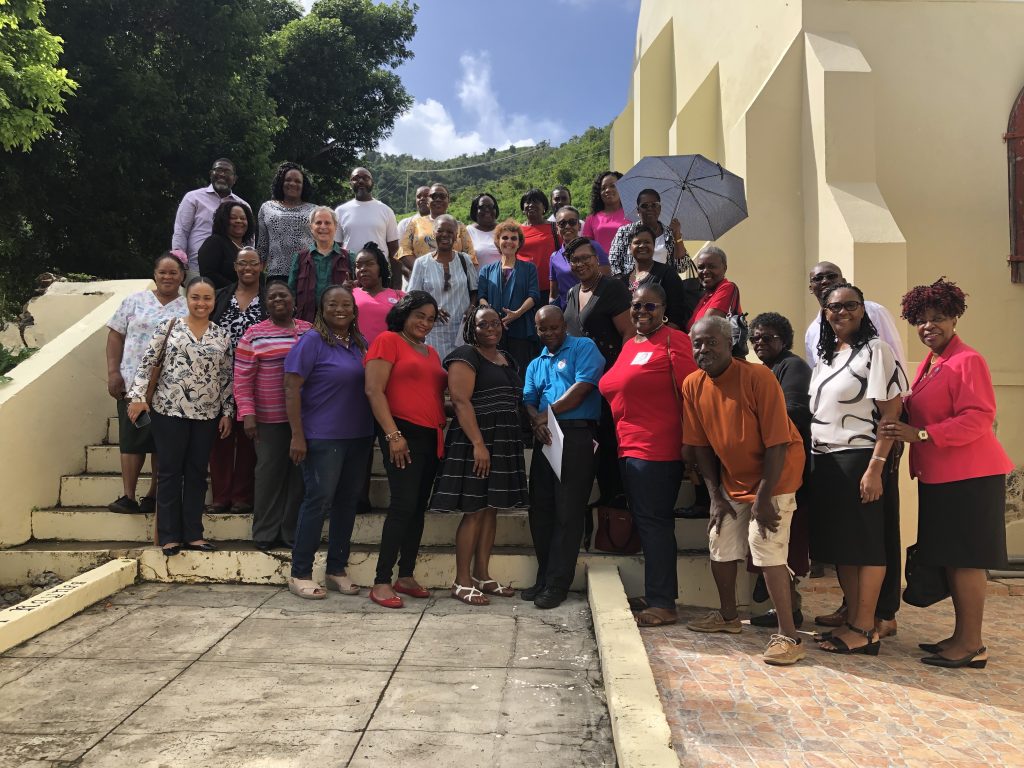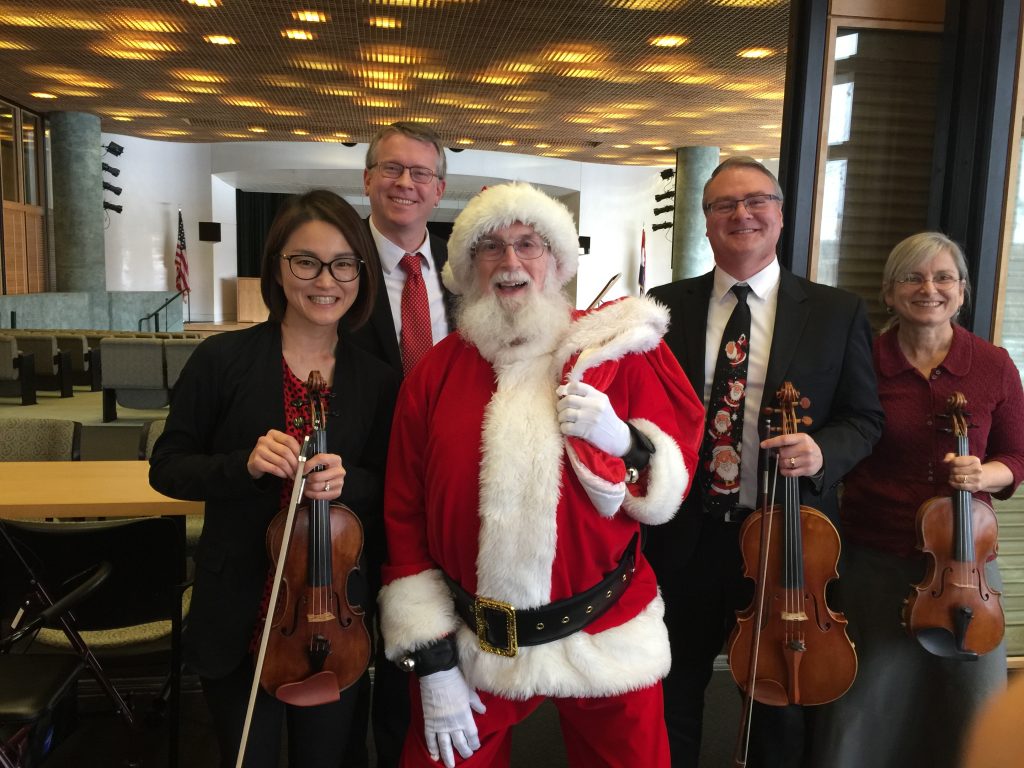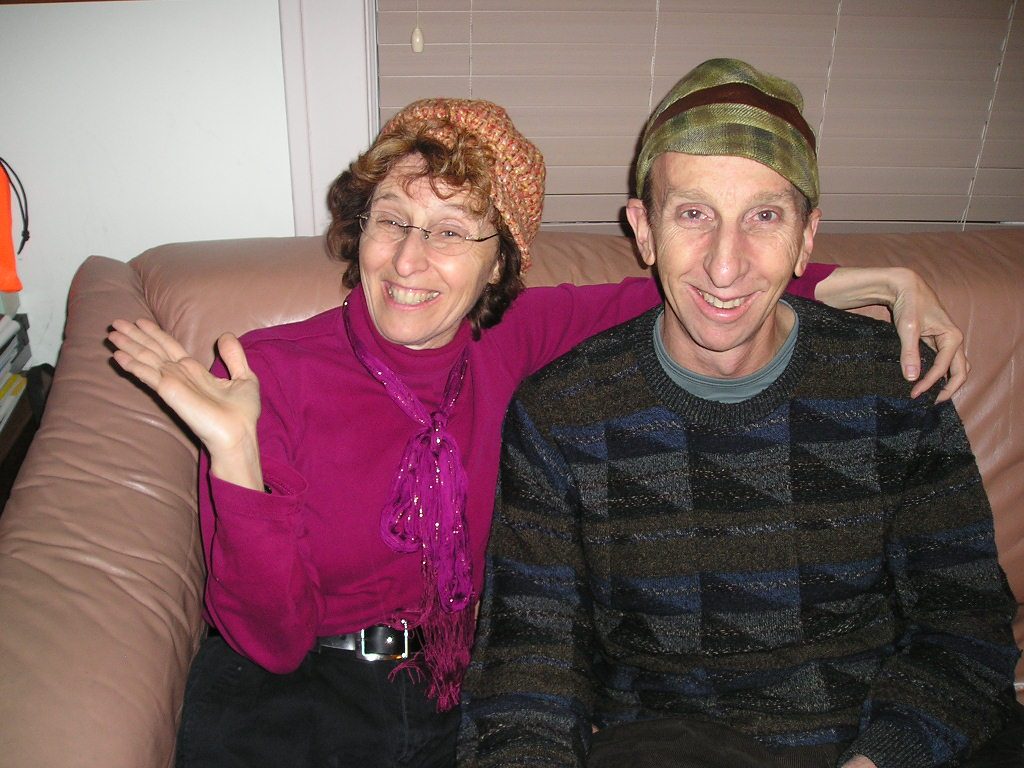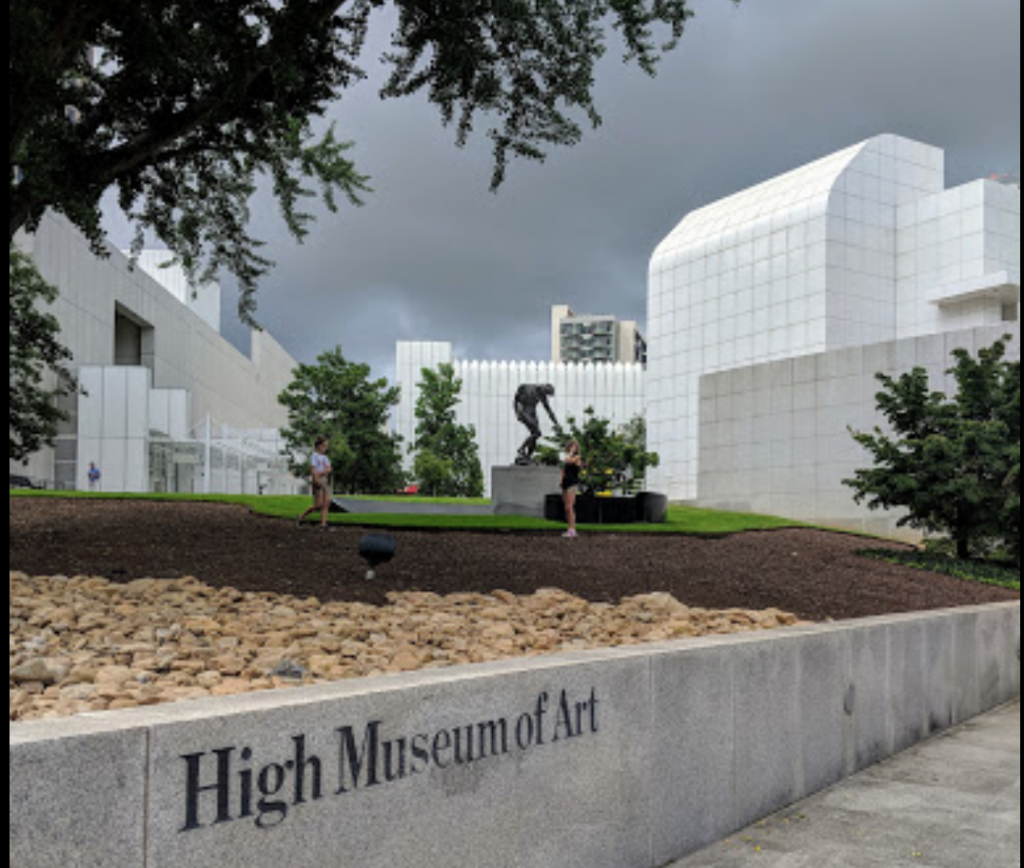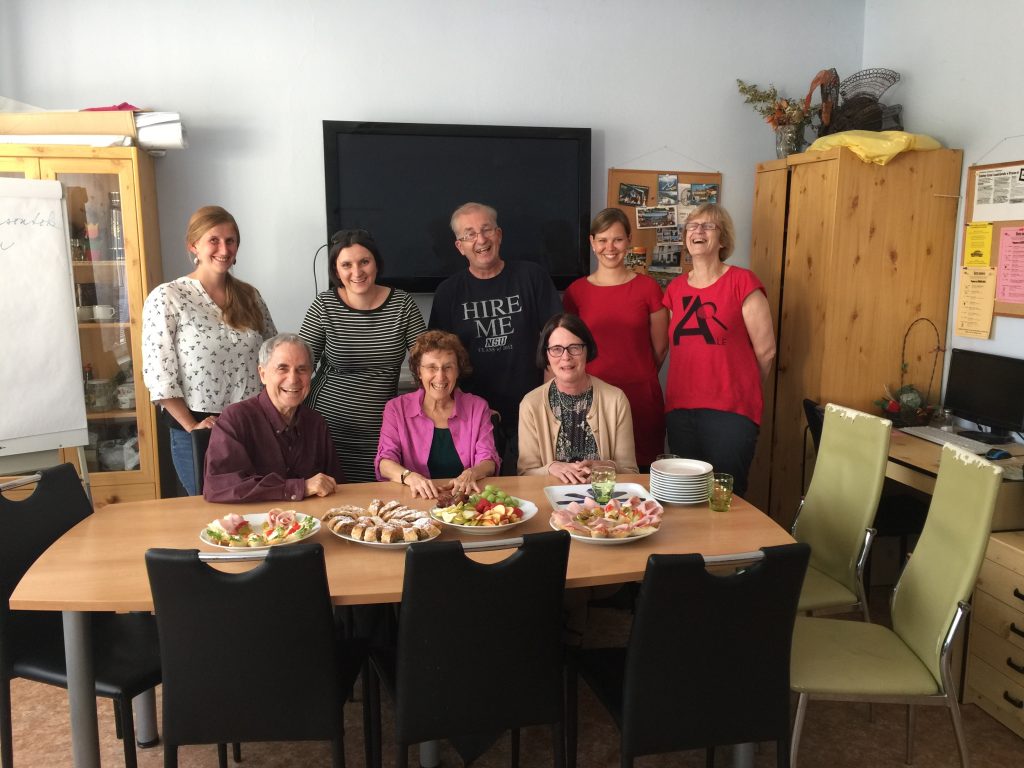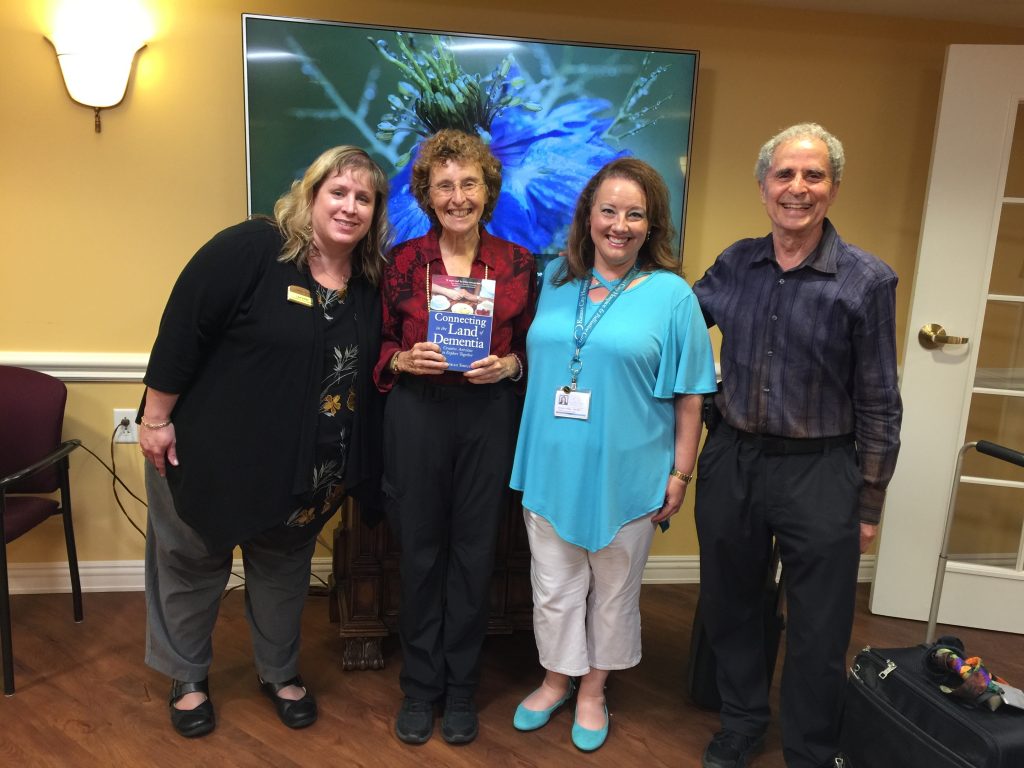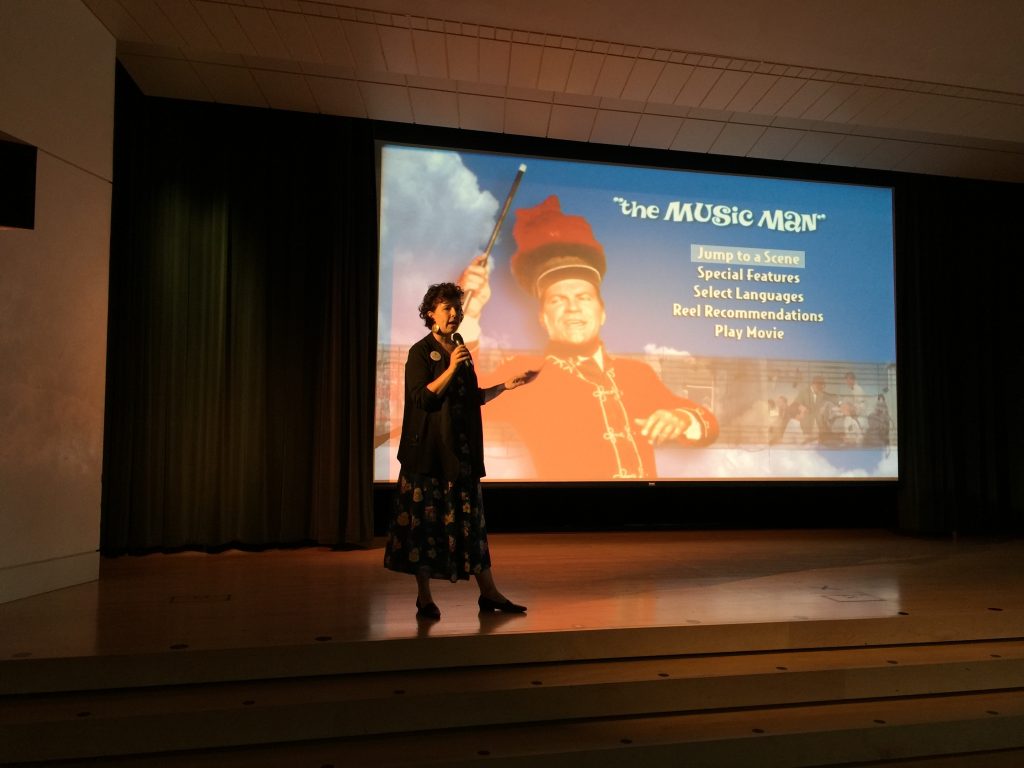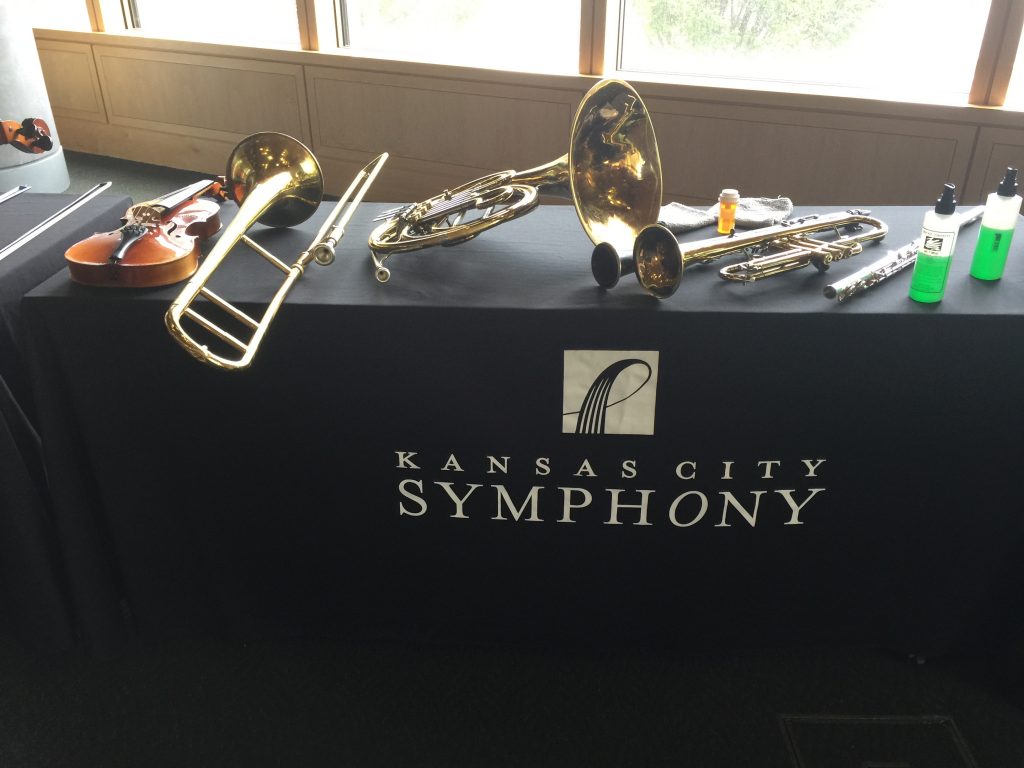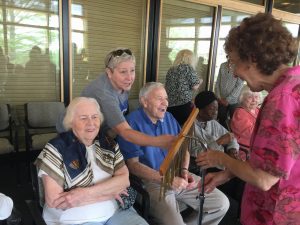Inspiration
Presenting to Care Partners in Tortola: The Power of One Person to Make a Difference
The founding of the Virgin Islands Alzheimer’s Association in Tortola, BVI, is about the power of one person to make a difference. It started at a Rotary Club meeting in 2013 when a fellow Rotarian confided in Edna Williams, “I have been diagnosed with Alzheimer’s.”
He told her how hard it was to find support and resources. Edna felt compassion for her friend and others in his situation. As a trained social services worker, human resources consultant, and woman of action, she went to work to remedy the situation. The results: a vibrant Association recognized by Alzheimer’s Disease International. The Association and its many volunteers serve as advocates for people who are living with dementia and their friends and families.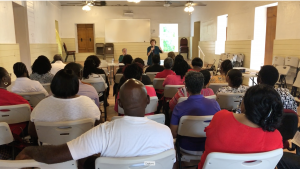
We were honored to spend time with Edna and to share our presentation with a group of family and professional care partners, social workers, and community and spiritual leaders. As we talked about the strength of music to keep us connected, Dawn, the daughter of Edna’s Rotarian colleague, the man who had inspired the founding of the Association, stepped forward to tell us her own story.
For several years, her father had been listless and withdrawn, seldom showing interest in anything. She mourned his father’s dynamic personality and tried many things to lift his spirits and pique his interest. Then she came upon a favorite song of his from years back, a lively tune with a Latin beat.
“When I played that song for him,” she told us, “he came to life. His eyes brightened and he began to mouth, then sing the words. He leaned forward in his chair, wanting to get up and move. It was such a meaningful transformation. The music connected with him and that helped him connect with us.”
Her touching story was a reminder that arts and creativity can go beyond the rational mind and the spoken word and awaken our hearts and spirits.
As we shared ideas for staying connected with each other, regardless of our abilities, our own hearts and spirits were expanded by our time with Edna and her group. It’s wonderful to live in a place of breathtaking beauty. It’s even greater to live in a community where people reach out to help and support their neighbors.
Five Ways to Make Valentine’s Day Special for a Loved One Living with Dementia
My parents liked to celebrate Valentine’s Day with dinner and dancing. Years into my mom’s Alzheimer’s journey, my parents’ love hadn’t diminished, but my mom’s capacity for going out to dinner and dancing had drastically decreased. I saw how blue my father was—one more event he had to give up, one more change in the woman he loved—and I searched for alternatives that might cheer him up. Here are five ways to make Valentine’s Day special.
Look for a favorite thing. Seek one simple pleasure your loved one might enjoy. Mom loved potato soup and chocolate and fresh strawberries. These were part of our celebration.
Nurture yourself: include your own favorite thing. Bring yourself into the celebration and include something that makes you happy. I brought foods my father and I both liked as part of our little party.
Pick several ways to express your love. Poetry, music, gifts, flowers, and photo albums—you can use any of these resources as a catalyst to talk about your feelings. Dad and I sang Mom old show tunes and love songs, music she really enjoyed. Mom adored Shakespeare; we had a couple of sonnets on hand. She and Dad had once created a beautiful flower garden; Dad brought her a single red rose.
Take joy in the simple act of expressing yourself. Being with my mom was a chance to really practice the mythical “unconditional love.” Mom couldn’t tell me she loved me. During one Valentine’s Day celebration, she fell asleep while I was holding her hand and talking sweetly to her. But there was a comfort in expressing my love and I kept on talking.
Celebrate love in all its glorious guises. During their long marriage, my father had walked into a room millions of times and often, Mom had been busy and hadn’t particularly smiled or remarked. But with her dementia came a deep dependency on Dad. When Dad walked into a room, my mother’s face lit up. My father basked in that light. The sparkle in my mother’s eyes was the new, “I love you, darling.” The light said everything my mother could no longer say.
Deborah Shouse is the author of Connecting in the Land of Dementia: Creative Activities to Explore Together and Love in the Land of Dementia: Finding Hope in the Caregiver’s Journey.
Singing in the Season with the Kansas City Symphony at the KC Memory Cafe
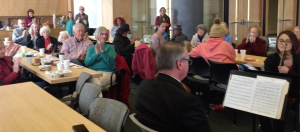 We were already in a holiday mood. A layer of sparkling snow blanketed Kansas City. Our generous neighbors at Cosentino’s Market in Brookside donated fresh-baked sugar cookies, colorful frostings, and cheerful sprinkles so our guests could decorate their own holiday cookies. Now we were ready for singing in the season with the Kansas City Symphony at the KC Memory Cafe.
We were already in a holiday mood. A layer of sparkling snow blanketed Kansas City. Our generous neighbors at Cosentino’s Market in Brookside donated fresh-baked sugar cookies, colorful frostings, and cheerful sprinkles so our guests could decorate their own holiday cookies. Now we were ready for singing in the season with the Kansas City Symphony at the KC Memory Cafe. 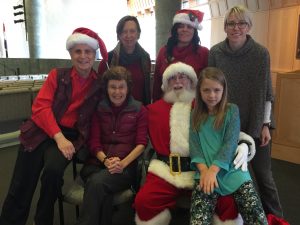 As the musicians launched into Jingle Bells, we heard an extra jingling. It was our own Santa Claus, bringing us his jolly “Ho, ho, ho’s” and a bag of Christmas cheer. We all sang, “We Wish You A Merry Christmas,” celebrated our musicians, and had our photos taken with Santa. We left humming and hopeful.#
As the musicians launched into Jingle Bells, we heard an extra jingling. It was our own Santa Claus, bringing us his jolly “Ho, ho, ho’s” and a bag of Christmas cheer. We all sang, “We Wish You A Merry Christmas,” celebrated our musicians, and had our photos taken with Santa. We left humming and hopeful.#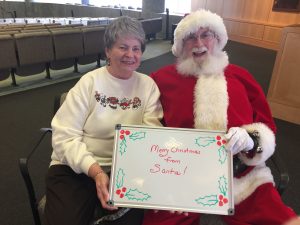 Thanks to the KC Symphony for the amazing gift of music. Thanks to Cosentino’s Market for the delicious treats. And thanks to our attendees, our Dementia Friendly partners, and our amazing community volunteers.
Thanks to the KC Symphony for the amazing gift of music. Thanks to Cosentino’s Market for the delicious treats. And thanks to our attendees, our Dementia Friendly partners, and our amazing community volunteers. A Thanksgiving Love Story: Bringing Home the Gravy
Thanksgiving changed the year I went vegetarian. I did not mind giving up the tender, moist turkey or the savory oyster-specked stuffing. But giving up the flavorful flow of mushroom-laden gravy was quite another thing. I watched enviously as my family ladled the luscious liquids over their mashed potatoes, turkey and stuffing. As I nibbled dryly on my carrots, green beans and salad, my lower lip protruded. I felt left out and deprived.
My brother, Dan, ever alert to the pouting big sister, came up with a solution.
“Next year I will make special vegetarian gravy just for you,” Dan promised.
Years later, that special vegetarian gravy has become one of my favorite Thanksgiving rituals. I begin fantasizing about it the moment the autumn leaves turn crimson. I know that in mere weeks, my brother and his family will arrive and I will have my yearly boost of family and feasting, highlighted by gravy.
When my brother calls to tell me his travel plans, I write his arrival time and GRAVY on my calendar. The night he comes to town, we make the shopping list together, avidly discussing how many pounds of mushrooms we need for both the carnivore and vegetarian pots of gravy. I relish the early-Wednesday morning trip through the grocery store, where Dan and I and our children carefully select the foods we will be making the next day. We linger in the produce aisle, filling several sacks with gleaming white mushrooms and buying rustling yellow onions.
On Thanksgiving Day, Dan and I and other family members spend long, luxurious hours cooking. Dan mans the stove and I manage the slicing and chopping. Together we snap, peal, slice and dice the vegetables that will accessorize the turkey. I take special pleasure in wiping clean and slicing the mushrooms, then bringing my brother the brimming bowlful. When he has nodded his approval, I get out the old copper pot I bought in Germany in the early seventies. This year, Dan is improving his already amazing gravy. With his new immersion blender, he creates a rich base of caramelized onions, whose flavor surpasses that of the lowly vegetable cube. He adds in a little flour, then gentles the mushrooms into the onion broth. When the pot is bubbling with thickening nectar, he says, “Taste this and see what you think.”
I always think the same thing—“Wow, this is great.”
We are in a state of giddy and satisfied exhaustion by the time our guests arrive. We share grateful prayers with everyone and lay out the feast, including plenty of turkey-based gravy for the rest of the family.
Then comes the moment I have been waiting for: I sit down, my own personal pot of gravy poised by my plate. I cover the mashed potatoes, carrots, green beans, and salad with the aromatic concoction and I savor every bite. But more importantly, I savor the bounty, creativity, and love that have gone into this simple dish. Through this gravy, my brother speaks with his hands and his heart, saying: “I care about you and I am going to make sure you are not left out and that you have something fantastic to eat.”
For that and so much more, I am thankful.
…………
And now, if you’d like to create a Thanksgiving love story, bring home this delicious gravy.
Dan Barnett’s Chicago Style Never-Enough-Mushroom Vegetarian Gravy
Ingredients
2 large onions (chopped)
2 pounds (or more) white button mushrooms sliced (can add some portabellas for enhanced flavor)
1 cup of white wine (of lesser quality)
Salt & pepper to taste
2 tablespoons of cornstarch
Olive oil
For 5 cups of water, start out with 2 vegetable boullion cubes. Add more if needed.
Directions
To create the gravy base:
In a four-quart pot, pour a thin layer of olive oil and turn the burner on medium.
Add the onions and sauté for10-15 minutes until they are caramelized (golden brown)
Add water until the pot is about half full.
Simmer slowly for 30 minutes.
Blend the onion water mixture using either an immersion blender or by transferring the mixture to a food processor.
Add the 2 pounds (or more) of sliced mushrooms white wine and fill the pot with water until it is 3/4 full. Simmer for 15-20 minutes.
In a small bowl, put 2 tablespoons of cornstarch. Pour in a small amount of the broth. Once it’s a smooth paste, pour in more liquid to make it a runny paste. Then pour the mixture slowly back into the gravy while stirring. This will thicken it. You may have to do this a couple of times to achieve the desired thickness.
Simmer for 30 minutes and season to taste with salt and pepper.
###
Deborah Shouse is the author of Connecting in the Land of Dementia: Creative Activities to Explore Together and Love in the Land of Dementia: Finding Hope in the Caregiver’s Journey.
Musing Together: Looking at Art Expands Skills, Increases Socialization, and Widens Horizons
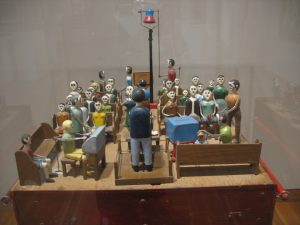 The group pauses in front of a large contemporary sculpture, depicting a preacher standing before his congregation at a small country church. They walk around the piece, noticing the pews, the organist, and the variety of parishioners, and chatting as they view. Then they settle into chairs and co-facilitator Esther Smith asks: “What is one word that comes to mind when you look at this piece of art.”
The group pauses in front of a large contemporary sculpture, depicting a preacher standing before his congregation at a small country church. They walk around the piece, noticing the pews, the organist, and the variety of parishioners, and chatting as they view. Then they settle into chairs and co-facilitator Esther Smith asks: “What is one word that comes to mind when you look at this piece of art.”
“Boring,’ says one woman.
“What makes it boring?” Esther asks.
“It brings me back to my childhood, when I was stuck in church for hours,” she answers. “I was so bored.”
A few others nod. Someone asks, “When was this made? Where is it from?” and the conversation about the art continues.
Every month at the High Museum in Atlanta, Georgia, Teaching Artist Esther Smith guides a group of care partners and people living with dementia on a 90-minute gallery exploration called Musings Together.
“It’s a light-hearted, interactive experience,” Esther says. “We go at a slow pace, seeing only three to four works each time. We want people to have a comfortable, personalized experience with art.”
 The open-ended conversation brings out people’s stories and ideas. Sitting in front of Giovanni Bellini’s Madona and Child, Esther asks, “What lines do you notice in this painting? Trace them in the air with your hand.”
The open-ended conversation brings out people’s stories and ideas. Sitting in front of Giovanni Bellini’s Madona and Child, Esther asks, “What lines do you notice in this painting? Trace them in the air with your hand.”
After people trace their lines, she asks, “What line was most interesting to you?” That question might lead into a discussion of what makes this painting different. Then Esther might invite the group to pose like the picture. She might say, “How would that baby’s head feel in your hand?”
“These simple prompts launch us into deep conversations,” Esther says. She and her team are experimenting with expanding the sensory experience, including bringing out oranges when they’re gazing at a still life of fruit and letting each guest hold and examine the orange. Esther also invites people to occasionally sketch an aspect of a drawing that appeals to them, using a drawing pad on a clipboard.
“ A number of our participants have never been regular museum-goers. Now they feel comfortable here and come more often,” Esther says. “Developing a new community of friends and an expanding interest in art enriches their lives.” #
Want to look at art with someone who is living with dementia?
If you’re visiting a museum, focus on a gallery with 3-4 large and interesting pieces. Ask a docent for advice, if needed. If you’re at home, give yourself plenty to time to comfortably view a few works of art on-line or in books.
- Bring a folding chair, so you can sit.
- Chose a time of day when your partner is energetic and the gallery is relatively quiet.
- Have fun just noticing the aspects of the piece. You might invite comments on colors, textures, familiar figures, objects that seem odd to you, and other aspects.
- Ask open-ended questions, such as, “What does this piece make you think of?” “What do you like about this piece?” “How do you think that main guy feels?”
When attention wanes, move onto something else, including a lovely coffee or tea break.
Click to view informative and inspiring short videos on our YouTube channel
Deborah Shouse is the author of Connecting in the Land of Dementia: Creative Activities to Explore Together and Love in the Land of Dementia: Finding Hope in the Caregiver’s Journey.
Czech Mates in Dementia Care: Laughter Yoga in Prague
The table was spread with an array of Czech delicacies: apple strudel, special sandwiches with flowers of ham atop fresh baguettes, a bountiful tray of strawberries, grapes, and apple slices. 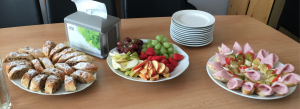
“This is the way we welcome people here in Prague,” said Lucie Hajkova, social worker and coordinator of respite care for the Czech Alzheimer’s Society.
Ron and I were visiting the Gerontological Centre and the Czech Alzheimer’s Society, which are both housed in the same building. The two organizations work together to offer clients everything they need, from psychological counseling, to memory testing, to social work services, to healthcare. We came to learn and to present a laughter yoga session.
We gathered with staff members around the table to learn about the center, which was started in 1997 by Iva  Holmerova, MD. along with Hana Janeckova, PhD. Hana was putting together training materials for caregivers when she was contacted by Alzheimer’s Disease International. They wanted to know more about her work and they invited her to an international conference in Jerusalem. That conference was a turning point. Hana left it inspired and determined to help Czech families that were dealing with dementia. She contacted Iva and both saw the need to offer education, diagnosis, support, and care for people living with dementia and their families in the Czech Republic. Today, both centers are flourishing.
Holmerova, MD. along with Hana Janeckova, PhD. Hana was putting together training materials for caregivers when she was contacted by Alzheimer’s Disease International. They wanted to know more about her work and they invited her to an international conference in Jerusalem. That conference was a turning point. Hana left it inspired and determined to help Czech families that were dealing with dementia. She contacted Iva and both saw the need to offer education, diagnosis, support, and care for people living with dementia and their families in the Czech Republic. Today, both centers are flourishing.
We were impressed with the dementia services they offered, which included home care for people who need help with bathing, dressing, eating, exercise or more. The building holds a respite center. When families need renewal time, or when people living with dementia need extra care or healing time, they can stay in respite for up to a month. The Centre also hosts a day program that offers a variety of activities in a homey and comfortable setting,
Even more impressive than the Society’s services were its staff. Each had a passion for this work, a love for those who are living with dementia, and a compassion for their families.
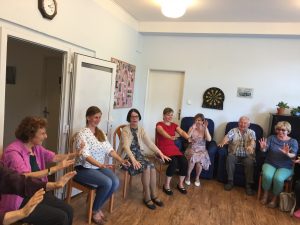
We had a wonderful time sharing a laughing session at the day center—our first international facilitation. We sat in a beautiful circle of people living with dementia, staff, family, and friends. We couldn’t have done it without our translator, Eliska, who captured the energy and essence of what we were saying. And once we all started laughing, we were beyond the constraints of language. Click here to experience a bit of laughter in Prague.
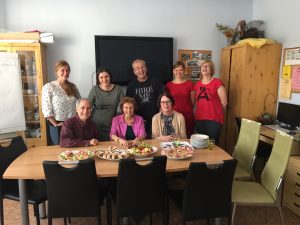
Photo Caption:
Eliska Brouckova, psychologist, consultant/advisor for people with dementia and their care givers
Martina Matlova, Director
Petr Veleta, PhD, dancer, dance therapist
Marketa Splichalova, psychologist, consultant/advisor for people with dementia and their care givers
Eva Jarolimova, PhD, psychologist, consultant for people with dementia and their care givers
Hana Janeckova, PhD, co- founder of the Czech Alzheimer Society, head of governing board of Czech Alzheimer Society, University teacher, researcher
Lucie Hajkova, social worker, coordinator of respite care in homes of people with dementia.
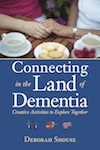
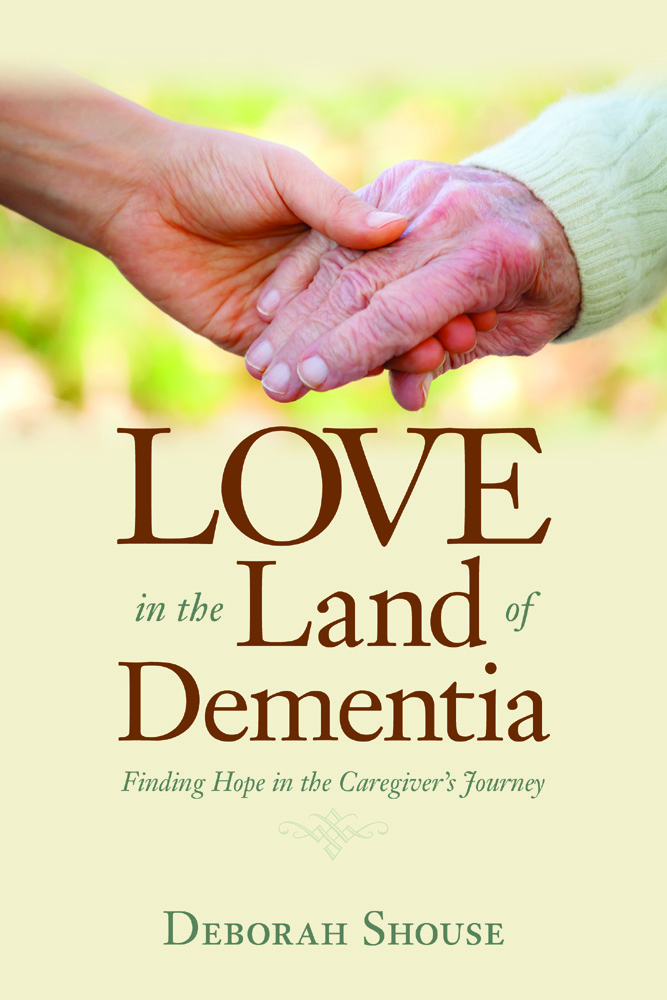
Celebrating Great Connectors Throughout the Dementia Journey: Music, Nature, and Laughter
When care partners gather and trade stories and ideas, there’s usually magic afoot. We felt that magic when we met with a group of family and professional care partners to celebrate great connectors throughout the dementia journey. We presented engaging ideas using music, nature, laughter and more.
Lisa Vetter, Director of Healthcare Sales & Marketing, Santa Marta Senior Living Community, invited us to speak at an event announcing the community’s new care partner support group. The group is led by Jennifer Walker, RN, BSN, Clinical Community Liaison, Kansas City Hospice & Palliative Care. Jennifer also facilitates the KC Memory Cafe and she is compassionate, informed, and smart. Most importantly, she has a fantastic sense of humor.
Ron and I shared ways to stay connected through singing and music, looking at works of art together, bringing nature indoors, and laughing. And our audience shared their experiences as well.
Here’s a story about nature that inspired us.
Marcie took her mom, who was living with dementia, on a fascinating monthly outing: they drove out into the country to look at the full moon. Her mother didn’t talk much anymore, but she loved seeing the night sky and gazing at the magnificent moon. One evening, as the moonlight spread over the car, Mom began singing, When the moon comes over the mountain. Marcie had never heard the song before and her eyes filled with tears at hearing her mom sing so strongly and clearly.
Here’s a story about the power of familiar music. Karen’s mom was a devout Catholic, living with dementia. Though there were many things she didn’t remember, including her daughter’s name, when she attended Sunday mass, she melodically sang every word of every hymn.
We loved sharing with this group of dedicated and compassionate care partners, who were all seeking ways to stay connected.
Here’s an extra tip from Connecting in the Land of Dementia: When you want to boost energy and lift spirits, add a splash of laughter into your life. Look at a clock and say, “We’re going to laugh for 30 seconds,” and start ha ha ha-ing. Or pretend you’re talking on the phone and hearing a hilarious joke. Or warble out the Ha Ha Chorus by singing the Happy Birthday song in “ha ha ha” syllables.


76 Trombones Star in June’s Movies and Memories Event
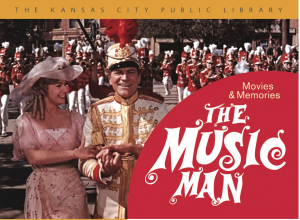 In The Music Man, people flock to hear about the idea for a band. They imagine the shiny instruments, the colorful uniforms, and the scruffy boys in their small Iowa town transformed into revered members of a marching band.
In The Music Man, people flock to hear about the idea for a band. They imagine the shiny instruments, the colorful uniforms, and the scruffy boys in their small Iowa town transformed into revered members of a marching band.
In the Movies and Memories showing of this iconic film, life imitated art.  During intermission, the Dirty Force Brass Band marched down the aisles of the Truman Forum, playing a zesty jazz number. People from the first floor of the library raced down the stairs, wanting to get closer to the music. Many of them stayed to watch the second half of the movie!
During intermission, the Dirty Force Brass Band marched down the aisles of the Truman Forum, playing a zesty jazz number. People from the first floor of the library raced down the stairs, wanting to get closer to the music. Many of them stayed to watch the second half of the movie!
This was the longest movie we’ve shown at our series and it was a big success. What a treat to see it on the big screen and to enjoy a very young and adorable Ronny Howard as Winthrope, the agile and the charismatic Robert Preston wooing the melodic Shirley Jones, as Marian the Librarian. And is there anything better that seeing a movie partially set in a library while you’re sitting in a library.!
You can click on this link to get the flavor of the event:
Movies and Memories: The Music Man
“We loved the music,” one family told us.
“This is my daughter’s favorite musical,” a mom told us, smiling at her four-year-old daughter.
“All this is free?” one of our guests said, relishing her popcorn and cookie.
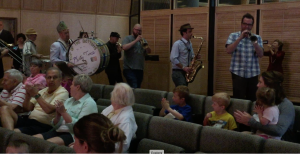
Every two months, the Movies and Memories treats the Kansas City community to a dementia and family friend film, along with live music and delicious snacks, and a surprise at the end. Everyone who attended was excited to take home various kinds of colorful noise makers. #
Please join us for our next dementia-friendly events:
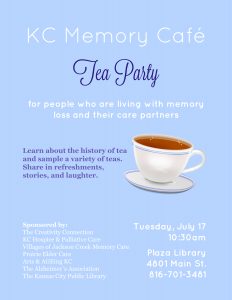
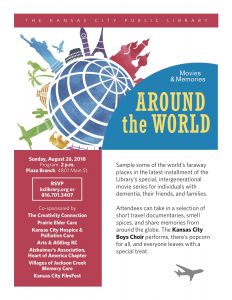
Mark your calendars for these upcoming events:
JULY
Tu 17 – Memory Café: Tea Party
AUGUST
Tu 21 – Memory Café: Nick Haines from KCPT
Su 26 – Movies & Memories: Around the World / KC Boys Choir
SEPTEMBER
Tu 18 – Memory Café: Nelson-Atkins
OCTOBER
Tue 16 – Memory Café: Wornall House
Su 21 – Movies & Memories: Moana, uke players, hula dancers
NOVEMBER
* Wed 14 – Memory Café: Dog & Pony & Pig Show
DECEMBER
Su 9 – Movies & Memories: holiday movie shorts & cookie decorating
Tu 18 – Memory Café: Santa & Symphony
Thanks to all our teammates who help make these gatherings happen:
The Kanas City Public Library
The Alzheimer’s Association
The Creativity Connection, Deborah Shouse and Ron Zoglin
Kansas City Hospice and Palliative Care
Arts & Aging KC
KC FilmFest
Prairie Elder Care
The Villages of Jackson Creek Memory Care
Dennis and Carol McCurdy, Community Volunteers


KC Memory Cafe Creates The Sounds of Music: A Visit from the Kansas City Symphony
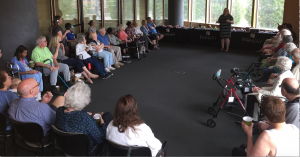 If there’s anything more fun than a one-man band, it’s a one-woman orchestra. On May 15, Margaret Halloin graced the cafe with an astonishing array of instruments. She invoked our inner Itzhak when she introduced us to the versatility of the violin. One moment she used a series of chords to transport us to a hoedown; then she built the tension by creating the sounds of of a chase scene. We were mellow with the cello and sliding cool with the trombone. We could all feel the beat as she tapped and shook a variety of percussion instruments. And then, she invited all of us to play
If there’s anything more fun than a one-man band, it’s a one-woman orchestra. On May 15, Margaret Halloin graced the cafe with an astonishing array of instruments. She invoked our inner Itzhak when she introduced us to the versatility of the violin. One moment she used a series of chords to transport us to a hoedown; then she built the tension by creating the sounds of of a chase scene. We were mellow with the cello and sliding cool with the trombone. We could all feel the beat as she tapped and shook a variety of percussion instruments. And then, she invited all of us to play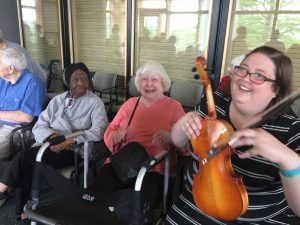 Instantly the room transformed from a quietly listening group of adults to a boisterous band of emerging musicians. One couple beat on a drum together. A woman tentatively held the violin. When Margaret helped her coax a sound of out it, she burst into delighted laughter. People tried the cello, the gong, the bongos, and the French horn. Even better than the sounds of music were the spurts of laughter and the lively conversations. After our chaotic impromptu concert, we gathered in small groups to talk about the music in our lives. One man had been a professional pianist. Several people had played in marching bands. Some had never touched an instrument. Until today.
Instantly the room transformed from a quietly listening group of adults to a boisterous band of emerging musicians. One couple beat on a drum together. A woman tentatively held the violin. When Margaret helped her coax a sound of out it, she burst into delighted laughter. People tried the cello, the gong, the bongos, and the French horn. Even better than the sounds of music were the spurts of laughter and the lively conversations. After our chaotic impromptu concert, we gathered in small groups to talk about the music in our lives. One man had been a professional pianist. Several people had played in marching bands. Some had never touched an instrument. Until today. 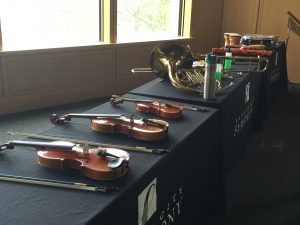
- Invite several musical kids/friends/relatives to come over, tell you about their instrument, and help you make a sound on it.
- Have fun playing imaginary instruments along with a big band or big orchestra music.
- Listen to favorite instrumentals and talk about any memories evoked.
- Look at pictures of various instruments and share stories. Ask open-ended questions with no right or wrong answers, such as, “ What do you think about the piano?” “What are some of your favorite instruments?”
Please join us for our next events:
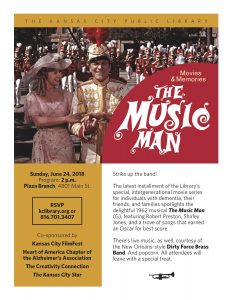
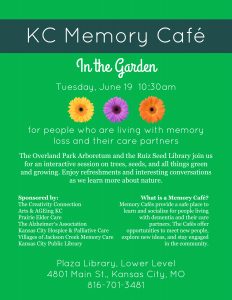


Using His Voice and His Skills: Mike Belleville’s Tips for Living Well with Dementia
“Here’s some medication,” the neurologist told Mike Belleville. “See you in six months.” The doctor stood up to leave, but Mike just sat there, exhausted from months of struggle and confusion, worn ragged from all the tests and consultations. For months, Mike, age 52, had been “hiding under a rock.” His mind wasn’t working right and he worried he’d make a mistake, so he withdrew from his busy life. Now, he was numbed by the diagnosis he’d just received; younger onset Alzheimer’s.
Those three words seemed insurmountable.
“My wife and I had no connection to support services and we had no idea what to do next,” Mike says. “We felt so alone.”
Without his job as a Senior Telecommunications Technician at Verizon, his community volunteer projects, and his hobby of photography, Mike sank into a depression. After several months, his wife found a program at their Alzheimer’s Association that focused on finding a purpose and living well with dementia.
“From meeting others who had the diagnosis, I realized, I can still enjoy, do, and learn,” Mike says. “But more importantly, I realized that I have a voice. I want to use that voice for as long as I can.”
Speaking Up
Even though he had no experience with public speaking, Mike plunged in and became an outspoken advocate, visiting Washington D.C., and speaking at a number of dementia forums.
“Somehow, I was comfortable discussing dementia,” he says. “Even when I was interviewed in front of 1300 people, I felt like I was sitting in a coffee shop, talking to a friend.”
He joined the advisory board of the Dementia Action Alliance and expanded his speaking and advocacy work.
Cooking Up New Skills
Mike was frustrated that he could no longer contribute financially to his household. So he searched for ways he could help around the house. He volunteered to do laundry and soon learned he did not “know when to fold ‘em.” Then he made a discovery: he could combine his desire to learn, his creative curiosity, his love of technology, and his desire to help through the joys of cooking.
Prior to dementia, hamburgers and hot dogs comprised Mike’s culinary repertoire: he could grill with the best of them.
“Thank goodness for Pinterest and YouTube,” Mike says. He searches for recipes on-line, then scans YouTube for a demonstration video, which he watches several times. He uses an App called Paprika, so he has the recipe in front of him. Then, Gordon Ramsey style, he lines up all his ingredients.
“Through trial and error, I learned to put away each ingredient after I added it in,” Mike says. “That way, nothing gets used more than once.”When his wife returns from work, they put the dish on the stove and cook the rest of the meal together.
“She’s very appreciative of my new talents and I’m happy to be exercising my brain and nourishing our family,” Mike says.
Putting Purpose to Technology
Early on, Mike volunteered at a local senior center, starting a technology group called, Mike’s Google Gals. Once a week, he helped people with their phones, tablets and computers. When he and his family moved, he volunteered to host a free Tech Corner on Dementia Action Alliance’s website, offering his problem solving skills as needed. He helps people get on line so they can participate in a vibrant virtual community.
“I get just as much out of this as I put into it,” Mike says. “The more I stay active, the better I am.”
Mike and his wife share an electronic calendar, so she can support him with his schedule. His vibrating smart watch offers reminders of meetings and appointments.
“Because I’m wearing the watch, I don’t have to worry about misplacing it and missing a text or an email,” Mike says.
Mike envisions home automation devices extending beyond moderating lights and temperature.
“I have an issue with anxiety,” Mike says. “I would like a wearable devise that automatically detects my anxiety. As I become more stressed, the device could turn on my TV, which would be tuned into a soothing video of my wife talking to me. Or it could turn on a calming musical playlist.”
Mike also envisions sensors that would alert his wife if he turns on the stove or walks out the front door. He would like to help develop these types of products.
Recipe for Living Well with Dementia
Mike views living with dementia as his new career.
“I’m using the same skills I honed in my earlier career,” he says.
His prescription for living well includes staying socially engaged, finding a purpose, and helping others.
At first, Mike saw his diagnosis as the end, but now he’s busy living. He has the Alzheimer’s logo tattooed on his arm with the motto, “Live life today.”


